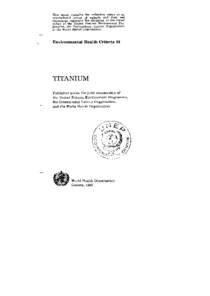Titanium

World Health Organization ; UN. Environment Programme
WHO - Geneva
1982
68 p.
animal experiments ; carcinogenicity ; chemicals ; metabolic process ; mutagenicity tests ; occurrence ; risk assessment ; sampling and analysis ; teratogenicity tests ; titanium ; toxic effects ; toxic substances ; toxicology
Environmental Health Criteria
24
Chemicals
English
Bibliogr.
92-4-154084-2
Titanium is a grey metal with an atomic number of 22 and a relative atomic mass of 47.9. It is extremely resistant to corrosion and, in the form of a powder or dust, is highly flammable and explosive. The most common oxidation state of titanium is +4, but +3 and +2 states also exist. Titanium occurs in both a cationic state (e.g., titanium chlorides, phosphates, and sulfates) and an anionic state (e.g., calcium, iron, and sodium titanates). Metallic titanium, titanium dioxide, and titanium tetrachloride are the compounds most widely used in industry.
Digital
The ETUI is co-funded by the European Union. Views and opinions expressed are however those of the author(s) only and do not necessarily reflect those of the European Union or the ETUI.